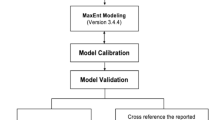Abstract
Schistosomiasis is a serious public health problem in the middle-lower Yangtze River Basin in China. Study of spatial variation of snail distribution that is related to microgeographic factors can help to choose pertinent measures for snail extinguishment and environment rebuilding. This paper studied the theoretical architecture of weights-of-evidence approach. The case study was made for spatial relation between the occurrence of infected snails and geographic factor combinations in Waijiazhou marshland of Poyang Lake region in China. The multievidence data came from the geographical factor combinations by crossing operation of vegetation coverage grade layer, cattle route distance grade layer, and special environment layer (181 combinations in total) in GIS. The calculation of weight contrast index shows that high vegetation coverage, cattle route distance of <45 meters, and special geographic factor “ground depression” had direct spatial relation with the occurrence of infected snails. The verification by crossing operation in GIS indicated 72.45% of the infected snails concentrated on the areas of positive weight contrast index (sequenced in an order of weight contrast index from high to low), demonstrating the high efficiency of the model established in finding infected snails according to the geographic factor combinations that can be explicitly discerned in the study area.
Similar content being viewed by others
References
Xu Bing, Gong Peng, Seto E, et al. (2006) A spatialtemporal model for assessing the effects of inter-village connectivity in schistosomiasis transmission [J]. Annals of AAG, 96(1): 31–46
Gong Peng, Xu Bing, Liang S (2006) Remote sensing and geographic information systems in the spatial temporal dynamics modeling of infectious diseases [J]. Science in China, Series C, 36(2): 184–192
Qian Xiaohong, Yang Jun, Chen Lin, et al. (2000) Study on physical-chemical properties in micro-environment for snail breeding in Anning watershed [J]. Curr. Prev. Med., 17(1): 15–17
Zhong Jiuhe, Zhang Shaoji, Liu Zhide, et al. (1995) Relation between snails and vegetation, soil in Poyang Lake region [J]. Chin. J. Schisto. Control, 7(4): 206–209
Zhang Xvdong, Yang Xiaochun, Peng Zhenghua (1995) Relation between snail distribution and environmental factors in grass beach [J]. Acta Ecologica Sinica, 19(2): 265–269
Chung C F, Fabbri A G (1999) The representation of geoscience information for data integration [J]. Nonrenewable Resources, 2(2): 122–139
Chung C F, Moon W M (1991) Combination rules of spatial geoscience information for mineral exploration [J]. Geoinformatics, 2(2): 159–169
Bonham-carter G F, Agterberg F P, Wright D F (1989) Weights-of-evidence modeling: a new approach to mapping mineral potential[M]//Agterberg F P, Bonham-Carter G F(Eds). Statistical Applications in the Earth Sciences. Ottawa: Geological Survey Canada
Jacob Kporfor, Chen Jiago (2005) Prediction of hydrothermal copper, gold, silver and lead-zinc in Northwestern Yunnan using weight of evidence model [J]. Geo-spatial Information Science, 8(3): 230–234
Lee S, Choi J (2004) Landslide susceptibility mapping using GIS and the weight-ofevidence model [J]. International Journal of Geographical Information Science, 18: 789–814
Romero-Calcerradaa R, Luqueb S (2006) Habitat quality assessment using weights-of-evidence based GIS modelling: the case of picoides tridactylus as species indicator of the biodiversity value of the finnish forest [J]. Ecological Modelling, 196: 62–76
Masetti M, Poli S, Sterlacchini S (2007) The use of the weights-of-evidence modeling technique to estimate the vulnerability of groundwater to nitrate contamination [J]. Natural Resources Research, 16: 109–119
Yuan Hongchang, Zhang Shaoji, Jiang Qingwu (2003) Theory and practice in schistosomiasis control [M]. Shanghai: Fudan University Press
Zhang Shaoji, Liu Zhide, Li Guohua, et al. (1990) Study on snail distribution and susceptible areas of schistosomiasis in Poyang Lake region [J]. Chin. J. Parasitol. Parasitic Dis, 8(1): 8–11
Yang Wenchang (2002) Survey on distribution of infected snails in Xinlian village [J]. Chin. J. Schisto. Control, 14(5)
Author information
Authors and Affiliations
Corresponding author
Additional information
Supported by a the National Natural Science Fundation of China (No. 30590370), the Research Project “Spatial Simulation of Schistosomiasis Susceptible Areas in the Poyang Lake Region” Sponsored by Science Research Plan 2007 of Jiangxi Normal University (Natural Science Category).
About this article
Cite this article
Zhao, A., Bao, S. & Gong, P. Using weights of evidence in the spatial relation between infected snails and geographic factors. Geo-spat. Inf. Sci. 12, 217–224 (2009). https://doi.org/10.1007/s11806-009-0079-2
Received:
Published:
Issue Date:
DOI: https://doi.org/10.1007/s11806-009-0079-2




